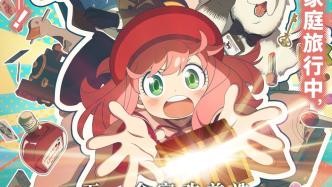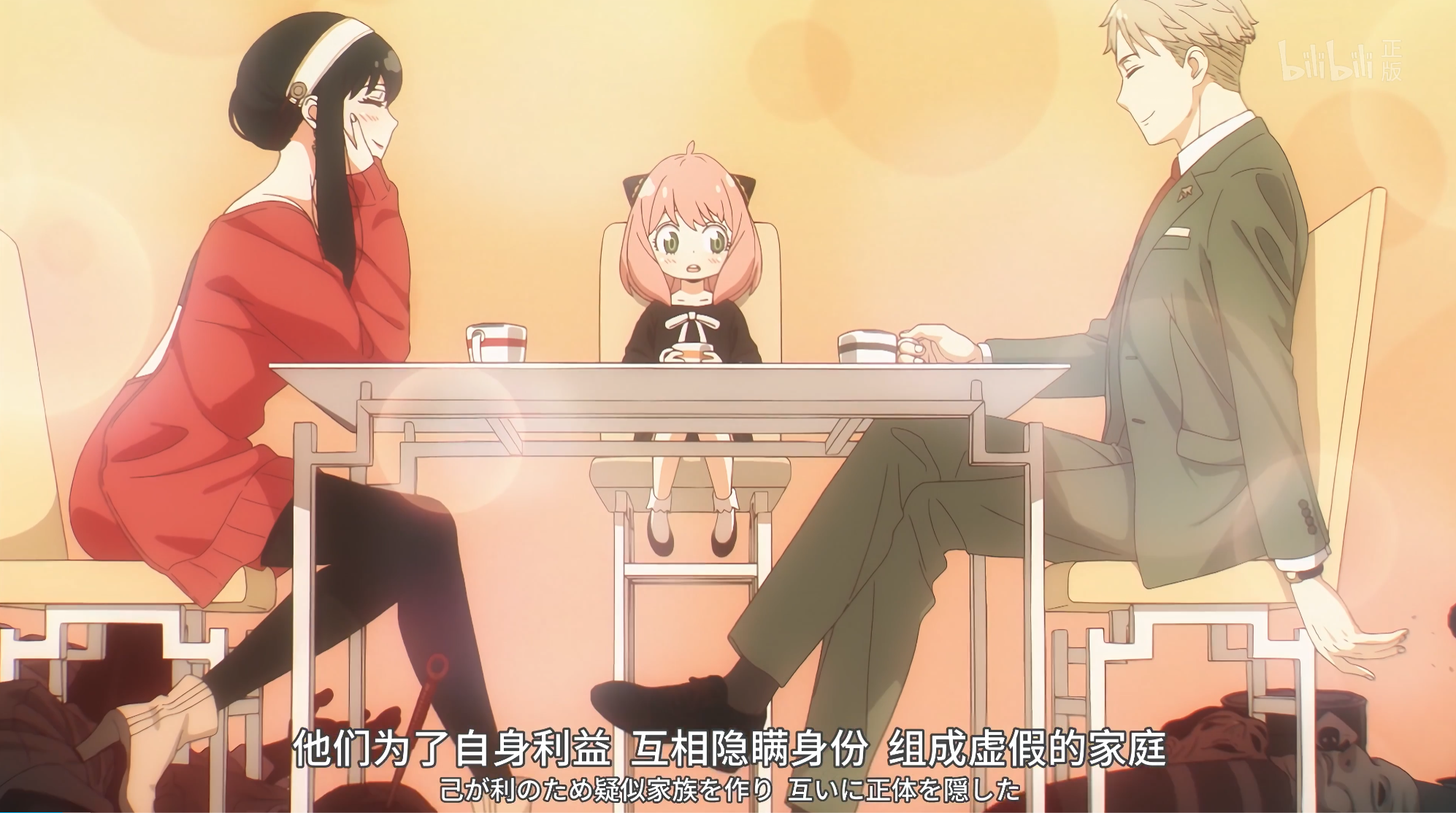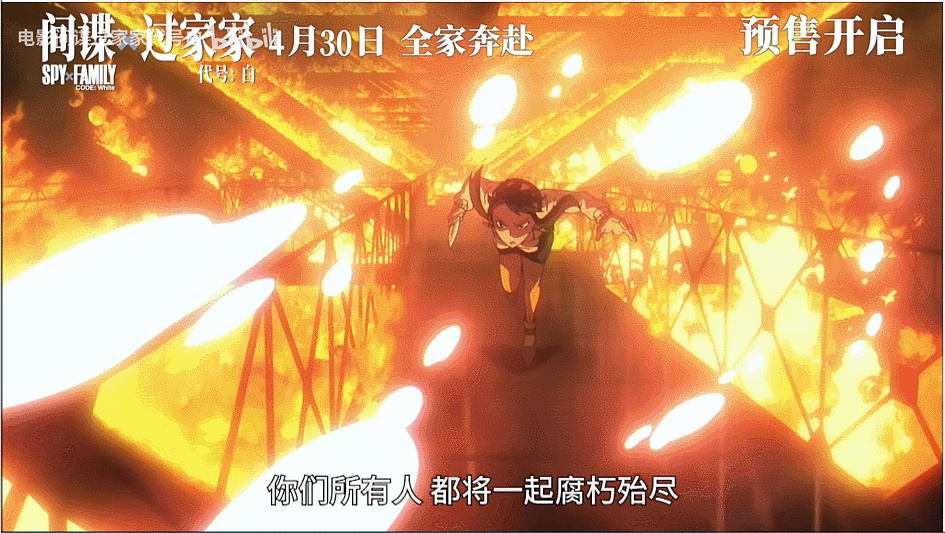
This year's May Day movie schedule can be said to be rich in genres, and for animation fans, the highlight of the May Day schedule is naturally "Spy Codename: White."

"Spy Play Codename: White" poster
Since the box office hit of Demon Slayer: Mugen Train, the model of "TV version accumulates popularity, theatrical version earns box office" has been adopted by more and more Japanese animations. Before Mugen Train, most TV animations that had theatrical versions were limited to long-lived national IPs such as One Piece, Detective Conan, and Dragon Ball. After Demon Slayer, theatrical animation has almost become a standard for highly popular animation IPs.
As a top new IP that has attracted much attention in recent years (the cumulative sales of the comics have exceeded 30 million copies, and the two seasons of TV animation have both received high broadcast volume), it is natural for "Spy Play" to launch a theatrical version. "Spy Play Codename: White" was released in Japan during the Christmas season last year. The film company promoted it very hard and also did a joint promotion with "Mission Impossible 7".

Collaboration with Mission: Impossible 7
The film also performed very well at the box office, winning the box office championship for four consecutive weeks after its release, and the cumulative box office exceeded 6 billion yen. It was not until the release of "Haikyuu!: Garbage Dump" in March this year that it gave up the box office championship position.
"Spy Play" is also very popular in China. The first two seasons of the TV version are available on major video websites. The funny segments suitable for short video dissemination, coupled with the popular Anya's cute emoticons, have made many domestic audiences aware of this new generation work, so the speed of introduction of this theatrical version is also very fast.

Aniya cute expression pack
Compared to the annual IPs such as "Detective Conan" and "One Piece" that rely on fans to support the box office, this film is very suitable for testing how much the Chinese pan-ACG fans can support the box office. When I watched the film, I observed the composition of the audience and found that they were basically young people in their teens and twenties, and women accounted for the majority. When I watched Hayao Miyazaki's "How Do You Want to Live" before, the audience was of all ages and genders, which shows the positioning of this film.
As the first theatrical version of the series, this film is very friendly to the audience, and newcomers who have not watched the animation will have no difficulty in appreciating it. The film begins by reintroducing the setting: the male protagonist Lloyd is a powerful spy "Dusk" from the West Country. In order to prevent the hostile East and West countries from starting a war, Lloyd sneaks into the East Country to carry out a secret operation to maintain peace.
In order to conceal his identity, Lloyd adopted an orphan named Anya, and pretended to be a couple with Joel, who was a civil servant. He also adopted a big white dog. But what Lloyd didn't know was that Anya was a person with the ability to read minds, Joel was a top killer of the East Country Assassination Organization, and the big white dog also had the ability to predict the future. The only person who knew everyone's identity was Anya.
In this way, the three of them concealed their identities from each other while secretly maintaining the fragile balance between the East and the West.

The Folger Family
The theatrical version follows the original plot. In order for Aniya to win the upcoming campus cooking competition, the family of three came to the Frigis region of the East Country to find local snacks that the judges love. On the train, Aniya accidentally swallowed a chocolate, which contained a microfilm. Once it was made public, it would trigger a war between the East and the West. The high-ranking officials of the East Country’s army planned to flee abroad with the film and then make it public. Surrounding the microfilm, the family of three once again took on the responsibility of stopping the war.
Before watching the movie, I expected that the movie would be similar to the several chapters in the original work (such as the cruise chapter), allowing the family of three to cooperate with each other to face more complex and dangerous challenges. The movie also follows this path from the trailer, but the actual difference is quite large. Rather than being an extension of the TV version, it is more like an introduction to the pit for new audiences. Rather than telling a complete chapter, it is more like splicing together a few unrelated episodes.

Stills from "Spy Play Codename: White"
The film is 110 minutes long, and the first hour or so is basically daily drama, with the regular characters in the TV version appearing one by one and showing their own character attributes. Unfortunately, the theatrical version did not use interesting designs to reinterpret these attributes, but just copied and pasted the simplest and crudest plot.
Dusk's disguised infiltration, Joel's strange strength to break the door, Anya's mind reading to help the two conceal their identities, Joel's brother couldn't wait to rush over when he thought Joel was in danger, and Dusk's fan girl Yewei was thinking about replacing Joel as Dusk's wife. These are all the same old plots in the TV version. They may be fresh to new audiences, but they are really boring for original fans like me.
What I want to see more is what new chemical reactions these attributes will have in new situations and environments. For example, in the TV version of the cruise ship, Joel had to protect the client while being careful not to expose his identity and solve the assassin in public. With the cooperation of Aniya, Joel disguised the battle as a circus performance and solved the assassin cleanly and performatively. This is a beautiful treatment.

Stills from "Spy Play Codename: White"
As for the plot that can be further explored, the theatrical version also chose the most unsophisticated method. At the beginning, Yoel misunderstood that Twilight had an affair. According to many scripts, this misunderstanding would trigger a series of accidents to promote the plot. Finally, at the climax of the ending, the misunderstanding was resolved through further interaction between the two, combining the emotional transformation of the characters with the plot twists.
However, in this film, Joel and Twilight cleared up the misunderstanding of an affair by just riding a Ferris wheel and chatting. The misunderstanding itself did not contribute much to the plot, but only added to Joel's attribute of being "ambiguous".
After watching the whole film, my feeling is that the main plot of "the battle for microfilm" cannot support the 110-minute length of the film, so the screenwriter wrote a bunch of daily scenes, but the daily scenes and the main plot lack connection and coordination, and the plot design lacks novelty, giving people a watered-down and fragmented feeling in the end.
Although I have complained so much about the plot arrangement, this is all from the perspective of the original fans, and the original fans are always more demanding. If you lower your expectations, this film is still qualified as a popcorn family movie. The combination of handsome men, beautiful women and cute kids is pleasing to the eye. Aniya's expressions and complaints are very stable. The final half-hour decisive battle is worth the price of the ticket, which can make people feel that "the funds are burning".
There are two scenes that impressed me the most in the final battle. One is the inner drama of Aniya holding back her poop, "The God of Poop". Although the poop and piss joke is a bit vulgar (considering Aniya's age, it is actually normal), the animation performance of this scene is really jaw-dropping. You will never see such a free-spirited scene in the original work.

Stills from "Spy Play Codename: White"
Another is Yoel's action scenes. If Yoel in the original film is a top killer, he has evolved to the level of a Marvel superhero in the theatrical version. Not only can he move at high speed under the barrage of machine guns, but he can also fight back and forth with cyborgs similar to the Terminator. The final lipstick kill is also very handsome. No matter how unscientific it is, it is indeed a feast for the eyes and fully demonstrates the expressiveness of animation.

Super exciting action scenes
As the theme of the series, the "family affection" drama is also performed well in the movie version. In the original work, because Yoel and Dusk had to hide their identities, the roles of the two were often very unbalanced. Usually one of them would solve the crisis with Anya in the open, while the other would inadvertently assist in the dark, and there was basically no obvious cooperation.
The theatrical version tried to balance the roles of the two this time, and also arranged for the family of three to cooperate in controlling the airship to avoid accidents. The arrangement of the roles was indeed thoughtful. At the end of the film, watching the family of three sitting on the airship and admiring the stars, the audience can also feel that although this family relationship is pretended, the family bond between the three is genuine.
Finally, a warm reminder: there is an easter egg after the ending song of this film. Aniya’s dance in the ending song is also very cute, so you can pay attention to it.